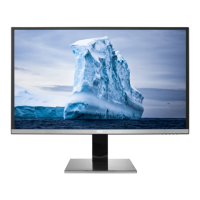Connecting the Monitor
Cable Connections In Back of Monitor and Computer:
1 DVI
2 MHL/HDMI
3 Display port
4 Analog (D-Sub 15-Pin VGA cable)
5 AUDIO IN
6 Earphone out
7 USB 2.0
8 USB 3.0+ fast charging
9 USB 3.0
10 USB input
11 Power
To protect equipment, always turn off the PC and LCD monitor before connecting.
1 Connect the power cable to the AC port on the back of the monitor.
2 Connect one end of the 15-pin D-Sub cable to the back of the monitor and connect the other end to the
computer's D-Sub port.
3 Optional – (Requires a video card with DVI port) – Connect one end of the DVI cable to the back of the monitor
and connect the other end to the computer’s DVI port.
4 Optional – (Requires a video card with HDMI port) – Connect one end of the HDMI cable to the back of the
monitor and connect the other end to the computer’s HDMI port.
5 Optional – (Requires a video card with DP port) – Connect one end of the DP cable to the back of the monitor
and connect the other end to the computer’s DP port.
6 Turn on your monitor and computer.
7 Video content supporting resolution:
(1) VGA/MHL: 1920 x 1080/60Hz (Maximum)
(2) DVI: 1920 x 1080/60Hz (Maximum)
(3) DVI Dual-Link: 3840 x 2160/30Hz (Maximum)
(4) HDMI1.4: 3840 x 2160/30Hz; HDMI2.0: 3840 x 2160/60Hz
(5) DP1.1: 3840 x 2160/30Hz; DP1.2: 3840 x 2160/60Hz
If your monitor displays an image, installation is complete. If it does not display an image, please refer
Troubleshooting.

